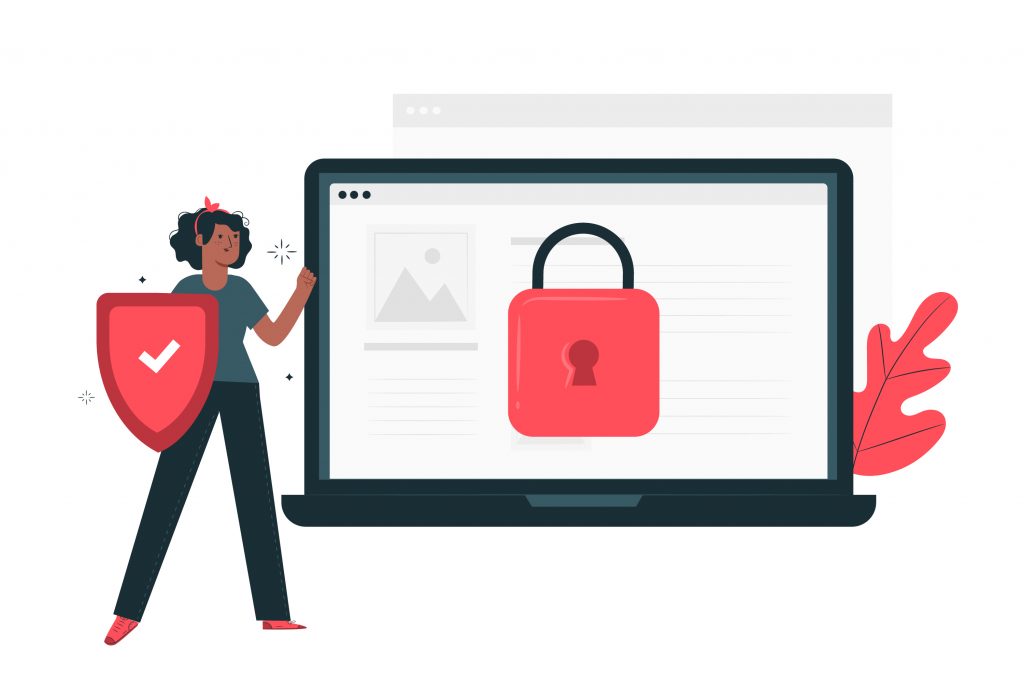Scam-Proof Your Online Shopping: Tips to Identify a Legitimate Website

Introduction
Online shopping has become a convenient and popular way for people to buy goods and services. With the rise of e-commerce platforms, purchasing products from the comfort of your home is easier than ever. However, as the number of online shoppers continues to grow, so does the number of online scams. Scammers can create websites identical to legitimate ones to steal your personal information or trick you into paying for something you will never receive.
According to Australian Scamwatch, the amount lost in the online shopping scam was 9 million – tiny compared to investment scams which are 377 million. However, it is still significant.
Be cautious when shopping online, as it can be challenging to tell a legitimate website from a scam. Some methods for identifying legitimate websites and avoiding scams were discussed in this blog post. We’ll discuss the importance of looking for a padlock icon in the URL bar, studying for a physical address and phone number, reading customer reviews, checking for a privacy policy, being wary of too-good-to-be-true deals, checking for spelling and grammar errors, and checking the website’s age.
Tips
These tips can help protect yourself from online scams and ensure you’re shopping on legitimate websites.
Search for the presence of a padlock icon in the website’s URL bar

When you visit a website, one of the first things you should look for is a padlock icon in the URL bar. This icon is usually located next to the website’s URL and indicates that the website is using a secure connection (HTTPS) to encrypt your information.
HTTPS stands for Hypertext Transfer Protocol Secure, a protocol used to secure data transfer between your computer and the website you’re visiting. It ensures that any information you enter on the website, such as your personal information or payment details, is encrypted and protected from being intercepted by third parties.
Websites that don’t have the padlock icon and use HTTP (Hypertext Transfer Protocol) instead may not be secure and could put your personal information at risk. In addition, scammers can create fake websites that look just like legitimate ones, and they may try to steal your personal information or trick you into paying for something you’ll never receive.
When you visit a website and see the padlock icon in the URL bar, you can click on it to see the website’s security information, such as the certificate authority that issued the certificate and the validity of the certificate.
It’s important to note that just because a website has the padlock icon doesn’t mean it is 100% secure. Some scammers can acquire legitimate certificates and use them for their fake websites. But, it is a good sign that the website is taking security seriously and is likely to be fair.
Checking for a padlock icon in the website’s URL bar is essential every time you visit a website. A padlock icon indicates that the website encrypts your information using a secure connection (HTTPS). Websites that don’t have this icon may not be protected and could be trying to scam you.
Check for a physical address and phone number

When shopping online, one of the ways to check if a website is legitimate is to check for a physical address and phone number. Legitimate websites usually have this information listed in the “Contact Us” or “About Us” sections. A physical address and phone number provide a sense of authenticity and legitimacy to the website and give you a way to reach out to the company if you have any issues or concerns.
A physical address can also be used to verify the website’s location. For example, you can use the address to look up the company on Google Maps or other mapping platforms to see if the place exists and if it is a commercial or residential area.
A phone number also allows customers to contact the company directly and ask questions or concerns. A legitimate company typically has a customer service number you can call during business hours.
A website with a physical address and phone number listed could be a red flag that it is not legitimate. Scammers may not want to provide this information as it makes it more difficult for customers to reach out to them and makes it easier for them to disappear.
It’s important to note that just because a website has a physical address and phone number doesn’t necessarily mean it’s a legitimate website. Scammers can also use fake addresses and phone numbers. However, it’s still a good sign that the website is legitimate, and it’s worth checking other factors to verify the authenticity of the website.
In summary, when shopping online, one of the ways to check if a website is legitimate is to check for a physical address and phone number. Legitimate websites will usually have this information listed on their website. If a website doesn’t have this information, it could be a red flag that it is not legitimate.
Check for customer reviews

Checking for customer reviews can be a valuable tool to verify the legitimacy of a website. Legitimate websites will often have customer reviews that you can read, giving you an idea of the experience other customers have had with the website.
Reading customer reviews can provide valuable insights into a company’s products, customer service, and shipping policies. You can check the reviews to see if other customers were satisfied with the product they received, if they had any issues with the website and if they received their orders on time. Positive reviews indicate that the website is trustworthy, while negative reviews can alert you to potential issues.
Another way to check the authenticity of customer reviews is to look for reviews on third-party websites such as Yelp, Trustpilot, or Better Business Bureau. These websites can provide unbiased customer reviews and a rating for the business.
However, it’s essential to know that some fake websites may also have fake customer reviews. These reviews may be positive and glowing, but scammers or paid reviewers could write them. To verify the authenticity of the reviews, you can look for reviews from multiple sources and check if they are detailed and specific or vague and generic.
In summary, checking for customer reviews can be a valuable tool to verify the legitimacy of a website. Legitimate websites will often have customer reviews that you can read, giving you an idea of the experience other customers have had with the website. If a website doesn’t have any reviews or the reviews seem fake, it could be a sign that the website is not legitimate. Be aware of fake reviews and check reviews from multiple sources to verify their authenticity.
Check for a privacy policy

When shopping online, checking for a privacy policy is an essential step in verifying the legitimacy of a website. A privacy policy is a statement that outlines the methods a website employs in collecting, utilizing and safeguarding your personal information. Legitimate websites will have a privacy policy that is easily accessible and easy to understand.
A privacy policy should provide information on the types of personal information the website collects, such as your name, email address, and payment information. It should also explain how the website uses this information to process orders or send marketing emails. Additionally, it should describe the measures the website takes to protect your personal information, such as encryption and secure servers.
Reading a website’s privacy policy can give you a good understanding of how the website handles your personal information and whether it takes your privacy seriously. If a website has a privacy policy that needs to be clarified, complete, or challenging to find, it could be a red flag that it is not legitimate.
It’s also important to note that scammers can create fake privacy policies. To verify the authenticity of the privacy policy, you can check if the procedure is consistent with industry standards and if the website is transparent about its data collection and usage practices.
In short, when shopping online, checking for a privacy policy is an essential step in verifying the legitimacy of a website. Legitimate websites will have a privacy policy that tells you how they use and protect your personal information. If a website doesn’t have a privacy policy or the policy seems fake, it could be a sign that the website is not legitimate. Be sure to read the policy and check if it is consistent with industry standards and the website is transparent about its data collection and usage practices.
Be wary of too-good-to-be-true deals

It’s essential to be wary of deals that seem too good to be true. While legitimate websites will often have competitive prices, they will be reasonable and achievable. If a website offers deals that seem too good to be true, it could be a sign that it is not legitimate.
Scammers may use unrealistic prices to entice customers to purchase, but they may not deliver the product or a fake or low-quality product. They may also use unrealistic prices to trick you into giving away your personal information or to scam you out of your money.
It’s vital to remember that if an offer appears too good to be true, it likely is. You should be cautious when shopping on a website that offers prices significantly lower than other websites or retail stores.
When shopping online, you can use price comparison websites to check the prices of a product on different websites. Additionally, you can research the product and the website to see if others have had positive experiences with the website and if the price is consistent with other websites.
It’s also important to keep an eye out for any red flags, such as spelling and grammar errors on the website, a lack of customer reviews, or a lack of a physical address and phone number.
In summary, when shopping online, it’s essential to be wary of deals that seem too good to be true. Legitimate websites will often have competitive prices, but they will be reasonable and achievable. If a website offers deals that seem too good to be true, it could be a sign that it is not legitimate. Be cautious when shopping on a website that prices are significantly lower than other websites or retail stores. Use price comparison websites and research the product and the website before making a purchase.
Check for spelling and grammar errors

When shopping online, checking for spelling and grammar errors is another way to verify the legitimacy of a website. Legitimate websites will typically have few spelling and grammar errors on their website, as they are usually created and maintained by professional teams. In addition, the website’s content should be well-written and free of errors, indicating that it takes its presentation seriously and is likely to be a legitimate website.
On the other hand, a website with many spelling and grammar errors can be a red flag that the website is not legitimate. Scammers may put less effort into the website’s content and may need more resources to hire professional teams to create and maintain the website. These errors can also indicate that the website is not updated frequently or not adequately maintained.
It’s also worth noting that spelling and grammar errors can signify a phishing website. These websites are created to steal personal information by tricking users into providing sensitive information, such as credit card numbers, login credentials, and other personal information.
It’s essential to keep in mind that while the presence of spelling and grammar errors may indicate a scam website, it is not a foolproof method. Some legitimate websites may make mistakes, and some scam websites may have perfectly written content. However, it’s still a good idea to check for spelling and grammar errors as part of your overall evaluation of a website’s legitimacy.
Checking for spelling and grammar errors is another way to verify the legitimacy of a website. Legitimate websites will typically have few spelling and grammar errors, indicating that the website takes its presentation seriously and is likely, to be honest. If a website has a lot of spelling and grammar errors, it could be a sign that it is not legitimate or could indicate a phishing website. Remember that this is not foolproof and should be used to evaluate a website’s legitimacy overall.
Check the website’s age

Checking the website’s age can be a helpful way to verify the legitimacy of website. One way to check the age of a website is to use a website like whois.com, which can provide information about a domain name’s registration date.
A legitimate website will typically have been registered for a considerable period, indicating that the website has a history of operation and has been in business for a while. On the other hand, a newly established website could indicate that it is not legitimate, as scammers may quickly create a fake webpage to exploit current events or trends.
It’s important to note that the age of a website alone does not guarantee its legitimacy. Scammers can also create fake websites that have been registered for a long time and make them look like it’s legitimate websites. However, checking the age of a website can give you an idea of the website’s history. Therefore, it can be used as one of many factors in evaluating the legitimacy of a website.
In short, checking the website’s age can be a valuable way to verify the legitimacy of the website. One way to check the age of a website is to use a website like whois.com, which can provide information about a domain name’s registration date. A legitimate website will typically have been registered for a considerable period. On the other hand, a website that has been recently created could be a sign that the website is not fair. Keep in mind that the age of a website alone is not a guarantee of its legitimacy, but it can be used as one of many factors in evaluating the legitimacy of a website.
Additional Tips
Check the website’s URL
Checking the website’s URL is an essential step in verifying the legitimacy of a website. Legitimate websites will have a URL spelled correctly and consistent with the brand name. The URL is the website’s address and should be easy to read and understand.
A legitimate website’s URL should be easily remembered and match the brand name. For example, if the brand name is “Online Shop,” the URL should be like “www.onlineshop.com.” Additionally, the URL should not contain any typos or extra characters, such as “-store.com” or “onlineshop-com.”
If the URL is misspelled or seems suspicious, it could indicate that the website is not legitimate. Scammers often use URLs similar to legitimate websites but with slight spelling variations or extra characters. These variations are often used to trick customers into visiting a fake website that looks similar to a legitimate website.
It’s essential to remember that a website’s URL alone is not a guarantee of its legitimacy. However, a legitimate website’s URL should be easy to read, remember, and match the brand name. An incorrect or suspicious URL could indicate that the website is not legitimate; therefore, it’s necessary to investigate further to confirm its authenticity.
In short, when shopping online, checking the website’s URL is an essential step in verifying the legitimacy of a website. Legitimate websites will have a URL spelled correctly and consistent with the brand name. If the URL is misspelled or seems suspicious, it could indicate that the website is not legitimate. Be cautious of URLs similar to legitimate websites but with slight spelling variations or extra characters. Remember that a website’s URL alone does not guarantee legitimacy.
Look for a return policy
When shopping online, checking for a return policy is an essential step in verifying the legitimacy of a website. Legitimate websites will have a clear and detailed return policy that outlines the process for returning products and obtaining a refund. This policy should be easily accessible and easy to understand and provide information on the conditions and time frame for returns and refunds.
A return policy signifies that the website values its customers and is willing to take responsibility for any product issues. It also indicates that the website has a process for dealing with customer complaints and issues, demonstrating its reliability and professionalism.
If a website doesn’t have a return policy or the policy seems unrealistic, it could be a sign that the website is not legitimate. Some scammers may need a return policy, or if they do, it may be unrealistic or impossible to meet the conditions, making it hard for customers to return the products or get a refund.
It’s essential to keep in mind that a return policy alone does not guarantee a website’s authenticity. Some scammers may also have a return policy, but they may not follow through with it. Therefore, it’s essential to read the return policy carefully and check if the conditions are reasonable and if the website is transparent about its return process.
Checking for a return policy is essential in verifying legitimacy when shopping online.
Check for a secure payment system
Checking for a secure payment system is crucial in verifying the legitimacy of a website. Legitimate websites will have a secure payment system that uses encryption to protect your personal and financial information. This ensures that your sensitive information, such as credit card numbers and billing addresses, is protected and cannot be intercepted by third parties.
One way to check if a website has a secure payment system is to look for a padlock icon in the URL bar or a web address that starts with “HTTPS” instead of “HTTP”. This indicates that the website uses a secure connection to encrypt your information, which is a sign that the website is legitimate.
Another way to check for a secure payment system is to look for security certification, such as PCI DSS compliance, which indicates that the website has met industry standards for protecting sensitive information.
If a website doesn’t have a secure payment system or the system seems suspicious, it could be a sign that the website is not legitimate. Scammers may use unsecured payment systems or fake payment pages to steal your personal and financial information.
It’s important to note that not all payment methods are created equal. For example, some websites may not accept credit cards but will take other forms of payment, such as crypto-currency or bank transfers which may need to be more secure. Additionally, some legitimate websites may use third-party payment processors, such as PayPal or Stripe, which provide an added layer of security.
Check for a secure checkout process
When shopping online, checking for a secure checkout process is an essential step in verifying the legitimacy of a website. Legitimate websites will have a fast checkout process that requires you to provide personal and financial information in a protected website area. This ensures that your sensitive information is protected and cannot be intercepted by third parties.
One way to check if a website has a secure checkout process is to look for a padlock icon in the URL bar or a web address that starts with “HTTPS” instead of “HTTP” during the checkout process. This indicates that the website uses a secure connection to encrypt your information, which is a sign that the website is legitimate.
Another way to check for a secure checkout process is to look for a security certification, such as PCI DSS compliance, which indicates that the website has met industry standards for protecting sensitive information during the checkout process.
If a website doesn’t have a secure checkout process or the process seems suspicious, it could be a sign that the website is not legitimate. Scammers may use unsecured checkout processes or fake checkout pages to steal your personal and financial information.
It’s essential to keep in mind that not all checkout processes are created equal. Some websites may use third-party checkout providers, such as Amazon Pay or Google Pay, which provide an added layer of security.
Research the company
Researching the company behind the website is an essential step in verifying the legitimacy of the website. By exploring the company, you can better understand the website’s reputation and credibility.
One way to research the company is to check its social media accounts, such as Facebook, Twitter, and LinkedIn. Legitimate companies will typically have an active online presence and use social media to connect with customers and promote their products or services. If the company has no social media accounts or the accounts seem suspicious, it could be a sign that the website is not legitimate.
Another way to research the company is to check for company registration information, such as a business registration number or tax identification number. Again, legitimate companies will typically have this information readily available on their website, which signifies that the company is transparent and accountable.
You can also check for online presence, such as customer reviews or press coverage. This can give you an idea of the company’s reputation and customer satisfaction. Legitimate companies will typically have positive customer reviews and have been covered by reputable media outlets.
If the company seems suspicious or has no online presence, it could indicate that the website needs to be legitimate. Scammers may create fake websites without an honest company behind them or with little online presence.
It’s important to remember that the absence of an online presence alone does not necessarily mean that the website is not legitimate. Some legitimate companies may have a weak online presence for various reasons. However, researching the company behind the website can give you a better understanding of its reputation and credibility. Therefore, it should be used as one of many factors in evaluating the legitimacy of a website.
In summary, researching the company behind the website by checking their social media accounts, company registration, and any other online presence is an essential step in verifying the legitimacy of a website. Legitimate companies will typically have an active online presence. They will use social media to connect with customers, have company registration information readily available and have positive customer reviews and press coverage. If the company seems suspicious or has no online presence, it could indicate that the website is not legitimate. However, it should be used as one of many factors in evaluating the legitimacy of a website.
Check the website’s customer service
Checking the website’s customer service is an essential step in verifying the legitimacy of a website. Legitimate websites will have customer service that is responsive, helpful, and easy to contact. This ensures that customers can get help and support and that the website is committed to providing a positive customer experience.
One way to check the website’s customer service is to look for contact information, such as a phone number or email address. Legitimate websites will typically have this information readily available and easy to find. Additionally, customer service should be available during regular business hours and respond to inquiries promptly.
Another way to check the website’s customer service is to read customer reviews. Legitimate websites will typically have positive customer reviews regarding their customer service. As a result, customers should be able to contact the company efficiently and receive helpful and timely responses to their inquiries.
If a website doesn’t have customer service or the service seems suspicious, it could be a sign that the website is not legitimate. Scammers may need customer service, or it may be hard to contact or unhelpful if they do.
It’s crucial to remember that customer service alone does not guarantee a website’s legitimacy. Some scammers may also have customer service, but they may need to follow through. Therefore, it’s essential to check how responsive, helpful, and easy-to-contact customer service is to evaluate the website’s legitimacy.
In summary, when shopping online, checking the website’s customer service is an essential step in verifying the legitimacy of a website. Legitimate websites will have customer service that is responsive, helpful, and easy to contact. This ensures that customers can get help and support and that the website is committed to providing a positive customer experience. If a website doesn’t have customer service or the service seems suspicious, it could be a sign that the website is not legitimate. Remember that just because a website has customer service doesn’t necessarily mean it is legitimate. It’s essential to check how responsive, helpful, and easy-to-contact customer service is to evaluate the website’s legitimacy.
Conclusion
When shopping online, it’s essential to be cautious and make sure that the website you’re using is legitimate. Scammers can replicate legitimate websites to deceive and steal personal information or trick individuals into paying for non-existent products. In this blog post, we discussed thirteen methods to determine the authenticity of a website and prevent falling victim to scams.
These include:
- Search for the presence of a padlock icon in the website’s URL bar
- Check for a physical address and phone number
- Check for customer reviews
- Check for a privacy policy
- Be wary of too-good-to-be-true deals
- Check for spelling and grammar errors
- Check the website’s age
- Check the website’s URL
- Look for a return policy
- Check for a secure payment system
- Check for a secure checkout process
- Research the company
- Check the website’s customer service
Combining these steps can increase your chances of identifying a legitimate website and avoiding a scam.
If you found this post informative, please also consider reading our other relevant posts:
- Unleashing Zero Trust: Cybersecurity’s Game-Changer!
- Next-Gen Endpoint Security: Emerging Trends to Know
- Scams Exposed: Unmasking Deception & Lessons
- Healthcare Supply Chains Reimagined: Blockchain Innovations
- Get in Touch with Security Vendors: Your Guide to Contacting VirusTotal and Beyond
- Protect Your Business: Avoid These Cybersecurity Mistakes
- Scam-Proof Your Online Shopping: Tips to Identify a Legitimate Website
- Don’t Fall for the Trickery: Understanding Social Engineering and How to Protect Yourself
- How to Make Apple iPhone/iPad More Secure
- How Secure is the Email Connection from End to End
If you love this article or any security posts and you would like to receive an update on this article or our latest post, please sign up for the form below:
Credits
- Image by Racool_studio on Freepik
- Image by storyset on Freepik
- Image by Freepik
- Image by jcomp on Freepik
- Image by storyset on Freepik
- Image by Pikisuperstar on Freepik
- Image by pch.vector on Freepik
- Image by pch.vector on Freepik









